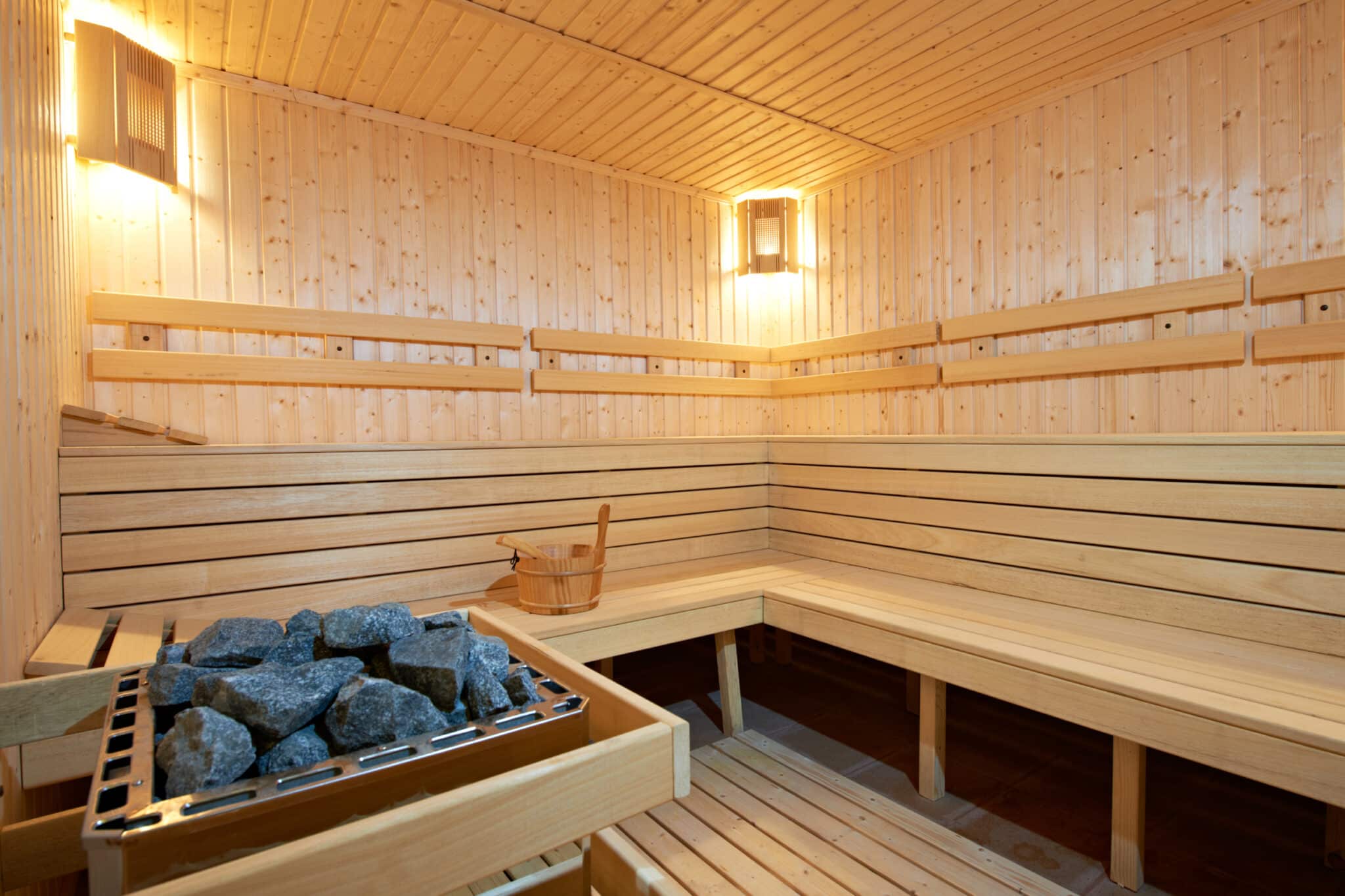Saunas have been used for centuries to relax, detoxify, and support overall wellness—but how exactly do they work? Whether you’re considering installing one at home or just curious about the different types, understanding how saunas generate heat (and how to use them properly) is the first step toward getting the most out of your experience. In this guide, we’ll break down how saunas work, explore 3 common types, and walk you through how to operate each one safely and effectively.
What is a Sauna?
A sauna is an enclosed, heated room, often with seating options such as benches. It usually reaches about 158℉–212℉ using various methods (which we’ll explain later). Sessions involve sitting in the heated room for an extended period, usually about 15–20 minutes, to experience various sauna benefits, including stress reduction, enhanced heart health, improved mental clarity, and more.
Each sauna works differently, depending on the form of heat they’re using. From dry heat to infrared lights, many methods are used to warm a sauna. Let’s look at 3 of the most popular types of saunas and how they work.
3 Types of Saunas & How They Work
The common denominator among all saunas is heat, which is the source of their powerful physical and mental health benefits. However, how they’re heated depends on the type of sauna—thus impacting how each one works. Here are 3 common types of saunas and how each operates:
1. How Does a Traditional Sauna Work?
A traditional Finnish sauna works by heating the air in the room first, which then warms your body. Traditional heated rooms operate at extreme temperatures, between 150℉–195℉. These saunas typically use heated stones, warmed by a wood-burning or electric stove. Sauna rocks are specially chosen for their ability to absorb and retain heat from the heating elements—whether electric or wood-burning. They’re designed to withstand high temperatures and hold heat for extended periods, helping you get a deep, consistent sweat session.
If you’re operating a traditional sauna with a wood-burning heater, you’ll need firewood to power it. Many individuals prefer this method due to its traditional feel, but it can be challenging to control the temperature. With practice, a wood-burning conventional sauna can be an immersive and beneficial experience. Most electric sauna heaters require a 220V power source to heat the stones, so it’s crucial to place your sauna where electrical wiring is easily accessible. It’s also important to note that stones can take 30–40 minutes to heat, so give yourself plenty of time to prepare the sauna before entering.
Dry vs. Wet Traditional Sauna: How Do They Work?
While traditional saunas can be quite dry, sprinkling water over the heated stones is a common practice that adds humidity—creating a steamy environment similar to a steam room (more on that later). If you’d prefer to skip the water, you’ll enjoy a “dry” traditional sauna, which works by using stones to warm the room—just without the added steam. If you choose to add water, you’ll experience a “wet” sauna, which introduces steam and humidity into the space. Wet saunas can tend to feel hotter than dry ones, but the overall impact and health benefits remain the same.
Traditional Sauna Routine: If you’re wondering how to work a traditional sauna, it’s pretty simple—as long as you know the proper steps. Start by turning the sauna on. Modern traditional saunas can be operated from a mobile app or built-in control panel, while older or wood-burning models may need you to light a stove manually. Once it’s on, set your desired temperature—or if you’re using a wood-burning stove, wait for it to preheat naturally. Next, you’ll follow 3 steps:
- Allow the sauna to heat up for about 30 minutes before entering. While you wait, rinse off in the shower to ensure your body is clean before stepping inside.
- Once the sauna is ready, step in and get comfortable. You can sit or lie on the lower bench; remember that the higher you sit, the hotter it will feel.
- Stay inside for about 15–20 minutes, or as long as you’re comfortable. After your session, step out and rinse off again, ideally with cool or lukewarm water. Be sure to hydrate immediately to replenish what you’ve lost through sweat.
2. How Does an Infrared Sauna Work?
Infrared saunas use infrared lights to warm the body directly without heating the air first. The infrared technology penetrates the body and raises the core temperature, often producing more pronounced sweating. These kinds of saunas use carbon panels or other sources of infrared heat to generate a temperature of 120℉—140℉, considerably lower than traditional saunas. Infrared saunas are generally dry with average humidity levels. They also don’t require pre-heat time like the warm stones of traditional saunas.
Infrared Sauna Routine: Learning how to work an infrared sauna is simple since these rooms are often user-friendly and can be powered on with a control panel or smart device. Start your infrared sauna routine by turning it on. Here are a few easy steps to follow from there:
- Set your desired temperature and session length. Most people start with temperatures between 110°F and 130°F for beginners and up to 150°F for more experienced users. Infrared saunas typically take about 10–15 minutes to warm up, but you can enter earlier since the heat is more gradual and less intense.
- Before entering, shower quickly to cleanse your skin and remove any lotions, oils, or sweat. This allows infrared rays to penetrate your skin better and gives you a fresh start.
- Once inside, get comfortable. Sit or lie on a towel to absorb sweat and protect the bench. Since the heat builds gradually, many people begin to sweat around the 10–15 minute mark. A full session typically lasts 30–45 minutes, but you can start with shorter durations and build up over time. Listen to your body. If you start feeling lightheaded, overheated, or uncomfortable, cutting your session short is perfectly okay.
- After your session, exit slowly and cool down. Rinse in the shower to remove sweat and toxins, ideally with cool or lukewarm water. Then hydrate thoroughly—your body just did some hard detox work and needs replenishment.
3. How Does a Portable Sauna Work?
Depending on the type, a portable sauna warms the space with steam, infrared light, or traditional heat methods (electric or wood-burning stove). Portable saunas are mobile and can be moved to different locations, outdoors or indoors, depending on your goals and preferences. There are 4 primary types of portable saunas, and each works a little differently:
- Towable saunas are traditional wood-lined saunas built onto trailers, making them easily transported. Towable saunas typically use wood-burning or electric stoves to heat sauna stones and the air inside, just like a traditional Finnish sauna.
- Sauna blankets are heated sleeping bags that wrap around your body. They use infrared heating elements embedded within the fabric, usually carbon fiber or tourmaline wires. These elements emit far-infrared heat that penetrates the body directly rather than heating the air, making them a compact and efficient option for at-home use.
- Tent saunas are pop-up structures made of heat-resistant fabric and are often used for outdoor or camping setups. Depending on the model, they’re heated using portable electric heaters, wood-burning stoves, or infrared panels. The interior can get surprisingly hot, and some allow you to add water to stones for a steam boost.
- Semi-portable freestanding saunas are larger units that resemble traditional indoor saunas but are designed to be disassembled and moved. Depending on the model, they typically use electric heaters or infrared panels. They’re ideal for home users who want a full-size sauna experience without committing to a permanent installation.
Portable Sauna Routine: If you’re using a semi-portable or towable sauna, you’ll work it similarly to a traditional or infrared sauna. However, tents and sauna blankets require a slightly different routine.
For Tent Saunas:
- Set up your tent sauna on a flat, heat-safe surface, indoors or outdoors. Make sure it’s properly ventilated and secured.
- Follow the manufacturer’s instructions carefully to prepare your heat source—whether it’s an electric heater, infrared panel, or portable wood-burning stove.
- Allow the tent to preheat for about 15–30 minutes, depending on the heat method and desired temperature.
- Rinse off in the shower before entering to help open your pores and keep the interior clean.
- Step inside and relax. Sit on a towel and enjoy 15–30 minutes, depending on your comfort level. Stay hydrated during your session.
- Cool down, rinse off after your session, and drink plenty of water to rehydrate.
For Sauna Blankets:
- Lay your sauna blanket on a heat-safe, flat surface—such as a yoga mat or bed covered with a towel.
- Preheat the blanket (if needed) using the control panel, setting the desired temperature—typically between 120°F and 160°F.
- Wear lightweight clothing or a sauna suit to absorb sweat and protect your skin from direct contact.
- Slide into the blanket and relax for 30–45 minutes, or as recommended. You’ll sweat gradually as the infrared heat penetrates your body.
- After your session, exit slowly and wipe down the blanket. Then, take a shower to rinse off sweat and rehydrate.
Saunas Work—It’s Proven. Why Not Try One for Yourself?
Now that you know how to work a sauna, it’s time to try it for yourself and experience the endless benefits. Qontrast is a 5-star sauna dealer in Northern Utah, offering customizable options—whether you’re looking for an outdoor heated retreat or a built-in sauna for your wellness room. We’re eager to help you achieve your health and wellness goals with the assistance of our state-of-the-art saunas. Contact us to schedule an appointment at our showroom and start building your dream sauna.


